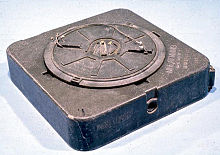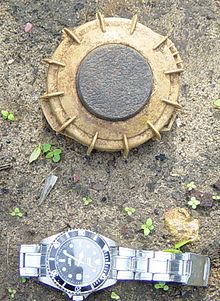Low-metal mine

Metal-poor or metal-free mines are special types of landmines . In contrast to common land mines, the metal content is reduced as much as possible or no metal is used at all. Low-metal mines can be anti-personnel and anti-tank mines , but also improvised explosive devices . Instead of metals, materials such as plastics, glass, wood, ceramics, cement, concrete or stone are normally used.
This type of mine is designed to serve the following additional purposes:
- Difficult finding of the mines by the enemy, therefore also increased time and material expenditure for clearing the mines and overcoming a corresponding mine barrier
- Saving metallic raw materials in the production of the mines and using these saved metals for other (war) goods
- Increased service life of the laid mines when using appropriate materials such as glass and plastic due to less corrosion; glass refills can be kept almost indefinitely if properly sealed
construction
In terms of development history, the first stage would be a mine in which the housing, detonator, other inner workings and possibly the splinter filling are made of metal. Almost the only non-metallic component is then the explosive it contains . The second stage of development would be the housing z. B. to manufacture from wood. The third stage of development would then be a mine in which all components that can simply be made from non-metallic materials can be converted accordingly. This applies above all to the housing, the interior except for the detonator and possibly the splinter filling. This leaves only the smallest parts of the (mechanical) detonator, which still consist of metal, whereby the total metallic mass is normally in the range of less than 3 g. Examples of components that are now still metallic would be e.g. B. springs , firing pins and shear bolts . The last stage of development is the completely metal-free mine. This is usually accomplished by replacing the simple mechanical igniter with a chemical igniter or by constructing a more complex mechanical igniter from non-metallic materials.
history
One of the first low-metal anti-personnel mines was the German glass mine 43 with lever detonator 44 and later a metal-free chemical detonator during World War II . About 11 million of these mines were produced between 1944 and 1945. One of the first metal-free anti-tank mines was the German pot mine in 1944 . These mines could not be detected with the metal detectors in use at the time. After the end of the Second World War and with the advent of plastics in industrial products, mines with a low metal content have also been primarily made from plastics since then. From the 1970s to 1993 ( Ottawa Convention ), Italian defense companies were some of the world's major suppliers of low-metal mines.
Mine clearance
The problem with the clearance is to find the mines safely. Since metal-free mines do not contain metal by definition, they cannot be located with normal metal detectors . For example, the following alternative search options are available for mine clearance :
- manual mine search, e.g. B. using a mine search needle , this is very time-consuming
- Use of animals (e.g. sniffer rats ) that smell the explosives of the mines and do not trigger the mines due to their low weight.
- mechanical mine clearing, e.g. B. by means of mine clearance tanks like the German boar .
Sometimes the user of low-metal mines wishes to be able to find them more easily after laying them. Some mines like the Italian VS-50 z. B. the option to attach an additional piece of metal. The Germans took a more exotic route here with the pot mine. They coated the mine with a black substance called tarn sand . This was radioactive and could easily be located using a Geiger counter .
It is not uncommon for metal-bearing anti-tank mines, like the Soviet TM-46 , to be laid in fields mixed with low-metal anti-personnel mines like the PMA-2 . The aim here is to make it more difficult for people to clear the anti-tank mines with metal detectors. Since the anti-tank mines contain several kilograms of metal and the anti-personnel mines only a few grams of metal, there is a certain area around each anti-tank mine in which the metal detector responds to the metal in the anti-tank mine and can no longer detect the low-metal anti-personnel mines. In this area, the metal detector is blind to anti-personnel mines, which puts the user of the metal detector at risk.
Examples
- Rifle mine 42 , Germany, 1942
- Glass mine 43 , Germany, 1943
- Pot mine , Germany, 1944
- M19 , USA , 1965, also made in Chile , South Korea , Turkey and Iran
- PRB M-409 , Belgium
- TMA-3 , Yugoslavia / Serbia
- PMA-2 , Yugoslavia / Serbia
- PMA-3 , Yugoslavia / Serbia, 1970
- VS-50 , Italy (Valsella Meccanotecnica SpA), also made in Iran, Egypt , Sweden , Singapore
- VS-MK2 , Italy (Valsella Meccanotecnica SpA)
- SB-33 , Italy (Misar SpA), 1977, also made in Greece , Portugal , Spain
- SB-81 , Italy (Misar SpA), 1981, also made in Iran, Portugal, Spain
- TS-50 , Italy (Tecnovar Italiana SpA), also made in Iran and Egypt
- TC / 3.6 and TC / 6 , Italy (Tecnovar Italiana SpA), 1970, also made in Egypt
literature
- Terry Gander, Peter Chamberlain: Encyclopedia of German Weapons 1939-1945 . 2nd Edition. Special edition. Motorbuchverlag, Stuttgart 2006, ISBN 3-613-02481-0
- TM 5-223, Foreign Mine Warfare Equipment, November 1957
- TM-E 30-451, Handbook of German Military Forces
- Catalog of Enemy Ordnance , 1945
- Jane's Mines and Mine Clearance 2005-2006
- Brassey's Essential Guide to Anti-Personnel Landmines
Individual evidence
- ^ A b Office of the Chief of Ordnance: Catalog Of Enemy Ordnance Materiel 1945, OCLC 464601649 .
- ↑ THE BRITISH ARMY IN NORMANDY 1944 . Imperial War Museum. Retrieved September 22, 2014.
- ↑ Terry Gander, Peter Chamberlain p. 359.
- ↑ Anti- personnel mines . Retrieved November 21, 2012
- ↑ Functioning, Assembly and Pictures of Glasminen (English) ( Memento of the original from January 22, 2009 in the Internet Archive ) Info: The archive link was automatically inserted and not yet checked. Please check the original and archive link according to the instructions and then remove this notice. , accessed June 11, 2012
- ^ Norman Youngblood: The Development of Mine Warfare: A Most Murderous and Barbarous Conduct . Greenwood Publishing Group, 2006, ISBN 978-0-275-98419-9 , pp. 115-.
- ^ German Explosive Ordnance (= Department of the Army Technical Manual TM 9-1985-2). US Government Printing Office, Washington March 1953, p. 308.
- ↑ TM-E 30-451 Handbook on German Military Forces , accessed June 11, 2012
- ^ Mine Detection Performance Comparison between Manual Sweeping and Teleoperated Robotic System . 2010. ( Page no longer available , search in web archives ) Info: The link was automatically marked as defective. Please check the link according to the instructions and then remove this notice.
- ↑ We train rats to save lives ( Memento from January 20, 2014 in the Internet Archive ) , on apopo.org . Retrieved January 27, 2014.
- ↑ Panzerbär, Keiler mine clearance tank (Bw) .
- ↑ boar . military-today.com.
- ^ The German M48A2 Keiler Engineering Vehicle . tanknutdave.com.
- ↑ For example with the Stuttgart 43 detector (TM 5-223)
- ↑ http://www.the-monitor.org/index.php/publications/display?url=lm/2004/singapore.html Landmine and Cluster Munition Monitor: Singapore
- ↑ Landmine monitor report 1999



